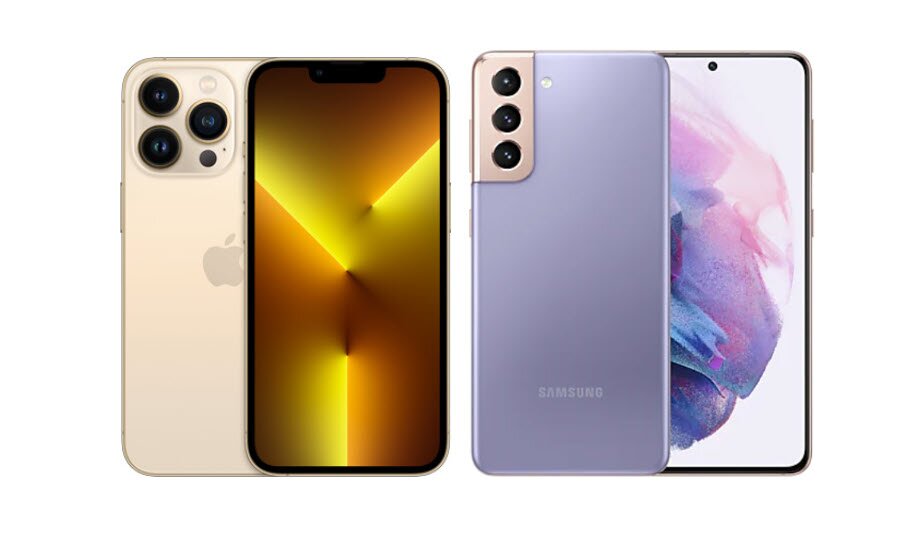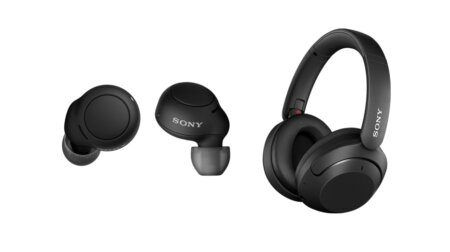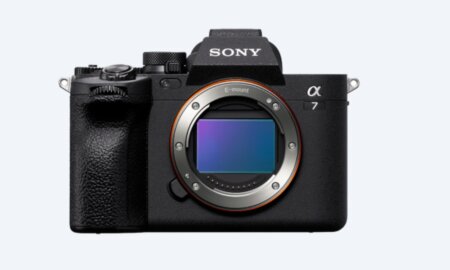This review compares the differences between the Apple iPhone 13 Pro and the Samsung Galaxy S21 5G. The iPhone 13 is officially launched on 14 Sep 2021 at the Apple online event at 1 PM ET., and the launch also includes Apple Watch 7, iPad Mini, and Airpods 3.
The Samsung Galaxy S21 5G was launched in January this year, which means Apple is released nine later and has more time to refer and pack in more features into the new iPhone 13 design. Some websites have already shown benchmarks that indicate Apple is ahead in processor speed, and Samsung is behind in many features not just to Apple but other brands as well.
In this comparison, we are pitting the iPhone 13 Pro with a 6.1″ display against the smallest Galaxy S21 5G with a 6.2″ display. We have also another review that compares the high-end flagship model in iPhone 13 Pro Max versus the Galaxy S21 Ultra.
Read more: Samsung Galaxy S22 Ultra is the new Galaxy Note?
Compare Form Factor[tie_index]Compare Form Factor[/tie_index]
| Tech Specs | iPhone 13 Pro (5G) | Galaxy S21 5G |
| Release Date | 14-Sep-21 | 14-Jan-21 |
| Form Factor | ||
| Size | 146.7 x 71.5 x 7.65 mm 5.78 x 2.81 x 0.30 in | 151.7 x 71.2 x 7.9mm 5.97 x 2.80 x 0.31 in |
| Weight | 203 g (7.19 oz) | 169 g (5.96 oz) |
| IP Rating | IP68 (6m for 30mins) IEC standard 60529 | IP68 (1.5m for 30mins) IEC standard 60529 |
| Material | Front: Ceramic shield. Back: Textured matt glass Frame: Stainless steel | Front & Back: Corning® Gorilla® Glass Victus™ Aluminum frame |
| Colors | Graphite, gold, silver, sierra blue | Phantom black, silver, navy, titanium, brown. |
The iPhone 13 Pro’s weight of 203gram is quite heavy for a phone with a merely 6.1″ display, but it is slightly more compact and thinner than the Galaxy S21 5G
The water ingress protection levels of the IP68 rating for both phones are significantly different. All iPhone 13 series including the mini versions are certified to a depth of 6 meters in water and for 30 mins.
Whereas for the Samsung Galaxy S21, the IP68 rating is certified to 1.5 meters for 30mins, which is much shallower. However, this should not be a major concern, unless you are a diver with plans to read the emails and watch Netflix at 6 meters underwater. Most swimming pools are just over 2 meters at the deepest point.
The iPhone 13 Pro has a ceramic shield that is tested to rival the Corning Gorilla Glass Victus in terms of crack and scratch-resistant.
Read: Ceramic Shield and Corning Gorilla Glass Victus Tests
So should you buy the iPhone 13 Pro for its IP68 rating or the Samsung Galaxy S21 5G that is much lighter?
Our buying decision points to the lighter Galaxy S21 because the weight affects us every day when we carry the phone. The 6 meters water protection is over-specified, unnecessary, and only useful for the minority.
Compare Display[tie_index]Compare Display[/tie_index]
| Tech Specs | iPhone 13 Pro (5G) | Galaxy S21 5G |
| Display | ||
| Screen Type | Super Retina XDR OLED display with ProMotion | Dynamic AMOLED 2X flat FHD+ |
| Screen Size | 6.1″ (90.2cm2) | 6.2″ (94.1 cm2) |
| Resolution | 2532×1170 pixels, 19.5:9 ratio, 460 PPI | 2400 x 1080 pixels, 20:9 ratio, 421 PPI |
| Brightness Max | 1000 nits max brightness (typical); 1,200 nits max brightness (HDR) | 1300 nits peak (typ) |
| Refresh Rate | 120 Hz, adaptive | 120 Hz, adaptive |
| Screen-to-body | 86.0% | 87.2% |
| Contrast Ratio | 2,000,000:1 | 2,000,000:1 |
| Colors | 10 bit, or > 1 billion colors | 16million |
| Color Gamut | Wide Color (P3) | DCI-P3 |
| Features | True Tone HDR display Haptic Touch Fingerprint-resistant oleophobic coating Support for display of multiple languages and characters simultaneously | HDR+ Certified Infinity-O Display: a near bezel-less, full-frontal screen. |
Main Difference between Super Retina XDR display and Samsung Dynamic AMOLED 2X
Both Apple Super Retina XDR display and Samsung Dynamic AMOLED 2X are based on OLED technology at least on the surface. If you are interested go deeper to understand the transistors, and capacitors, then check out AMOLED at Wikipedia.
What is relevant to consumers is that the Super Retina XDR display supports HDR10, Dolby Vision, and HLG format videos, while the Samsung display supports HDR10 and HDR10+ but not Dolby Vision.
HDR10+ as announced by Samsung and Amazon in 2017, is an update to the HDR10 by additional dynamic metadata used for more accurate brightness levels up to 10,000 nits, 10-bit color depth, and 8K resolution.
Both Apple and Samsung displays have been upgraded in recent years to support dynamic refresh rates from 60 Hz up to 120 Hz. The ability to automatically adjust the refresh rate helps to deliver the best quality image at the right time while saving the battery when it is not required.
The specifications may also show that the Samsung Galaxy is significantly brighter but all OLED displays might experience reduced brightness levels as the display ages over time. This is a common issue that could still happen to all consumer electronic products using OLED.
In conclusion, both displays are quite similar in terms of design specifications, however, the Samsung Galaxy loses some points for lack of Dolby Vision support and 24 bit (16.7million) colors only. That said, we do not feel that these are major factors that affect buying decisions.
Compare Hardware[tie_index]Compare Hardware[/tie_index]
| Tech Specs | iPhone 13 Pro (5G) | Galaxy S21 5G |
| Hardware & OS | ||
| OS | Apple iOS 15 | Android 11, One UI 3.1 |
| Chipset | A15 Bionic chip (5nm) New 16‑core Neural Engine | Qualcomm® Snapdragon™ 888 5nm power-efficient |
| Processor | Hexa-core 2×3.22 GHz 4x efficiency processor | USA/China: Octa-core (1×2.84 GHz Kryo 680 & 3×2.42 GHz Kryo 680 & 4×1.80 GHz Kryo 680) Worldwide: Octa-core (1×2.9 GHz Cortex-X1 & 3×2.80 GHz Cortex-A78 & 4×2.2 GHz Cortex-A55) |
| GPU | Apple GPU (5 cores) | Mali-G78 MP14 – Global Adreno™ 660 GPU – China/USA |
| RAM/Storage | 6GB/128GB, 6GB/256GB, 6GB/512GB, 6GB/1TB (NVMe) | 8GB/128GB, 8GB/256GB (LPDDR5/UFS 3.1) |
| SIM Card | Dual SIM (Nano + eSIM) Dual eSIM support | Dual Nano SIM or Single Nano SIM and eSIM |
| 3.5mm Ear Jack | No | No (USB-C) |
| Speaker | Two, Stereo | Two, Stereo, AKG Tuned |
| Security | Face ID | 2D Face unlock, In-screen fingerprint (Ultrasonic) |
| Stylus Support | No | Yes, S Pen |
| Sensors | Face ID Accelerometer LiDAR Scanner Three-axis gyro Digital compass Ambient Light Sensor Proximity Sensor Barometer | Accelerometer Face Recognition Fingerprint Sensor (Ultrasonic) Gyro Sensor Geomagnetic Sensor Hall Sensor Light Sensor Proximity Sensor Barometer |
The iPhone 13 Pro has a new 5nm A15 Bionic with a new 6-core processor, 16-core neural engine, and 5-core GPU. The new processors are more powerful with more features but are also energy efficient. The Samsung Galaxy S21 5G uses the Qualcomm Snapdragon 888 which is commonly used for most high-end Android phones now.
Compare Processor Benchmarks
In December 2020, Qualcomm released the following set of benchmark results for their new Snapdragon 888, which shows the improvements over the older A13, but loses out to the A14 on the iPhone 12 Pro. Based on the following results, therefore we can extrapolate safely to say that the A15 will be faster than the Snapdragon 888 processor.

Stylus and Fingerprint Sensor
The iPhone 13 Pro Max still has no stylus support and fingerprint sensor, despite the fact that Face ID is not going to work with a mask on during the ongoing pandemic. The fingerprint sensor has been used widely as a security feature in many types of devices and with a very long history. They have been used not just on phones, but computers, notebooks, and door security systems. Whoever suggested removing this feature on a smart device is not so smart.
Apple Dual eSIM
The other advantage is that Apple is introducing a new dual eSIM support in addition to one physical Nano SIM card. However, only two SIMs (eSIM or Nano SIM) can be active at any time, which means:
- Two eSIM (as long as Telco can support)
- One Nano-SIM and one eSIM
Users are required to assign the primary and secondary phone, and to pick either one as a “default”. By default, the iPhone uses the same number that was last used for a particular contact. If the contact is new, then the iPhone will use the default number, or the user can specify which number to use to call the contact.
Compare Battery[tie_index]Compare Battery[/tie_index]
| Tech Specs | iPhone 13 Pro (5G) | Galaxy S21 5G |
| Battery | ||
| Capacity | 3,150 mAH. Non-removable. (11.97 Wh) | 4000mAh (typ), non-removable. |
| Type | Lithium-Ion | Lithium-Ion |
| Wired Charging | Fast charging 20W 50% in 30 min | Fast Charging 25W 80% in 48 mins |
| Wireless Charging | MagSafe charging up to 15W Qi charging up to 7.5W | Fast Qi/PMA wireless charging 15W |
| Reverse Wireless Charging | No | 4.5W |
| Charging Technology | PD 2.0 | PD 3.0 Fast Wireless Charging 2.0 |
| Video playback | < 22 h (20h streaming) | < 20 h |
| Audio playback | < 75 h | < 68 h |
Comparison of battery performance between models is normally done by comparing both the battery capacity and playback time. The iPhone 13 Pro battery capacity was not shown on Apple’s website but was found via a filing posted at 9to5Mac. Even when the iPhone 13 Pro has a much smaller battery than the two, the official specs stated an impressive playback time of up to 22 hours video playback and 75 hours audio playback.
Samsung Galaxy S21 5G charges slightly faster than iPhone 13 Pro when using USB-C wire. For wireless charging, both phones have the same speed theoretically, assuming they are using 15W chargers.
PowerShare
Ever since Galaxy Note 10, Samsung has included reverse wireless charging called “PowerShare” in all its devices. The PowerShare function allows the phone to wirelessly charge other devices up to 4.5W. This feature can be used to charge any devices that support Qi wireless charging and is independent of the brand.
The conclusion for battery comparison is that Samsung Galaxy is still better than iPhone Pro by having the reverse charging function. This is not a new technology but useful for charge other accessories such as earbuds and smartwatches by keeping just one device, Galaxy S21, plugged in. Apple iPhone will not be able to do this and will need separate charges or cables to charge each device.
Compare Cameras[tie_index]Compare Cameras[/tie_index]
| Tech Specs | iPhone 13 Pro (5G) | Galaxy S21 5G |
| Rear Camera | ||
| Resolution | 12 MP(wide), f/1.5 12 MP(ultra-wide), f/1.8, 120˚FOV 12 MP, f/2.8 (telephoto) TOF 3D LiDAR scanner (depth) | 12 MP(wide) 26mm, f/1.8, , 1/1.76″, 1.4µm, 79˚FOV 12 MP(ultrawide) 13mm, f/2.2, 1.4µm, 120˚FOV 64 MP(telephoto) 29mm, f/2.0, 1/1.72″, 0.8µm, 76˚FOV, 3xhybrid zoom |
| Camera Features | – 3x optical zoom in, 2x optical zoom out; – 6x optical zoom range – Digital zoom up to 15x – Night mode portraits enabled by LiDAR Scanner – Portrait mode with advanced bokeh and Depth Control – Portrait Lighting with six effects (Natural, Studio, Contour, Stage, Stage Mono, High‑Key Mono) – Dual optical image stabilization (Telephoto and Wide) – Sensor‑shift optical image stabilization (Wide) – Six‑element lens (Telephoto and Ultra- Wide); seven‑element lens (Wide) – True Tone flash with Slow Sync – Panorama (up to 63MP) – Sapphire crystal lens cover – 100% Focus Pixels (Wide) – Night mode – Deep Fusion – Smart HDR 4 – Photographic Styles – Macro photography – Apple ProRAW – Wide color capture for photos and Live Photos – Lens correction (Ultra Wide) – Advanced red‑eye correction – Photo geotagging – Auto image stabilization – Burst mode – Image formats captured: HEIF and JPEG | – LED flash – Auto-HDR – Panorama – Scene optimizer – Shot suggestions – Filter and beauty effects – Night mode – Portrait mode – Food mode – Tracking auto-focus – Scan QR codes – Location tags – AR Emoji – SuperSpeed Dual Pixel AF, OIS (Wide) – Space Zoom –>Hybrid Optic Zoom 3x –>Super Resolution Zoom up to 30x – OIS (Optical Image Stabilization) – Format and advanced options (HEIF/Raw copies/UW shape correction) – Advanced recording options (HEVC/HDR10+/Zoom-in MIC) – Grid lines |
| Video recording | 4K: 24/25/30/60fps 1080p: 25/30/60fps 720p: 30fps | 8K: 24 fps 4K: 30/60fps 1080p: 30/ 60 /240fps 720p: 960fps |
| Features: | – Cinematic mode for recording videos with shallow depth of field (1080p at 30 fps) – HDR video recording with Dolby Vision up to 4K at 60 fps – ProRes video recording up to 4K at 30 fps (1080p at 30 fps for 128GB storage)* – Dual optical image stabilisation for video (Telephoto and Wide) – Sensor‑shift optical image stabilisation for video (Wide) – 3x optical zoom in, 2x optical zoom out; 6x optical zoom range – Digital zoom up to 9x – Audio zoom – True Tone flash – QuickTake video – Slow-motion video support for 1080p at 120 fps or 240 fps – Time-lapse video with stabilisation – Night mode Time‑lapse – Cinematic video stabilisation (4K, 1080p and 720p) – Continuous autofocus video – Take 8MP still photos while recording 4K video – Playback zoom – Video formats recorded: HEVC and H.264 – Stereo recording | – Video stabilization – HDR 10+ videos – Auto HDR – HEVC format – Portrait mode – Director’s view mode – Pro video mode – Super Slow-Mo Mode – Slowmotion mode – Hyperlapse mode – Digital zoom up to 12x – High CRI LED Flash – Tracking AF – Audio zoom – Take 33MP still photos while playing 8K video – Playback zoom – Video location tags |
Rear Camera Features
The table above summarises the camera features which we will not cover in detail in this review. If there is one feature that you need before you can decide which phone to buy, then you will need to research deeper into the haystack like a professional photographer.
For the hardware, we will say iPhone 13 Pro has an advantage with the LiDAR scanner, which is useful for capture 3D imaging and measure distance up to 5 meters.
Another feature of the iPhone 13 series worth highlighting is the Sensor-Shift Image Stabilization which uses the camera sensor to “shift” and stabilize during video recording rather than moving the lens. It is assessed to be better and produce better quality videos than the Optical Image Stabilization (OIS) used by Samsung Galaxy.
| Tech Specs | iPhone 13 Pro (5G) | Galaxy S21 5G |
| Front Camera | ||
| Resolution | 12 MP, f/2.2, (wide), 1/3.6″ | 10 MP(wide) 26mm, f/2.2, 1/3.24″, 1.22µm |
| Video capture: | 4K: 24/25/30/60fps 1080p: 25/30/60fps | 4K:30/60fps 1080p:30fps |
| Features: | – Portrait mode with advanced bokeh and Depth Control – Portrait Lighting with six effects (Natural, Studio, Contour, Stage, Stage Mono, High‑Key Mono) – Animoji and Memoji – Night mode – Deep Fusion – Smart HDR 4 – Photographic Styles – Apple ProRAW – Cinematic mode for recording videos with shallow depth of field (1080p at 30 fps) – HDR video recording with Dolby Vision up to 4K at 60 fps – ProRes video recording up to 4K at 30 fps (1080p at 30 fps for 128GB storage)* – Slo‑mo video support for 1080p at 120 fps – Time‑lapse video with stabilization – Night mode Time‑lapse – Cinematic video stabilization (4K, 1080p, and 720p) – QuickTake video – Wide color capture for photos and Live Photos – Lens correction – Retina Flash – Auto image stabilization – Burst mode | – Dual video call – Auto HDR – Wide-angle for group selfies – Save selfies as previewed – Set selfie color tone – AR Emoji – OIS – Dual Pixel PDAF |
Front Camera Features
It is apparent in the above table that Apple has placed a lot of emphasis on the design of a front-facing selfie camera, with enough features that rival the rear camera. Users can record up to 4K high resolution, cinematic mode, night mode, and stabilization. This could be the deciding factor for many users especially with the popularity of selfies. Samsung Galaxy S22 has quite a bit to catch up but until there, iPhone Pro 13 has an impressive front camera that is hard to beat.
Conclusion[tie_index]Conclusion[/tie_index]
We have omitted to discuss connectivity in our review above because the specifications are the same for both phones.
We will pick iPhone 13 Pro if we need both a good rear and front camera for photography and video recording. The iPhone 13 Pro is also compatible with a wider range of video formats, including the Dolby Vision which is missing on the Galaxy S21.
On the other hand, we will pick Samsung Galaxy S21 5G for its lightweight at 169 grams, and its support for Stylus (S-Pen), fingerprint sensor, USB-C connector, and PowerShare.






